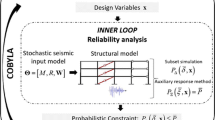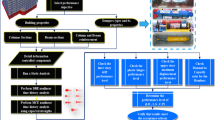Abstract
The working conditions of construction machinery are frequently harsh. To prevent excessive impact from causing mechanical failure, the performance of viscoelastic suspensions typically requires improvement. However, the elevated performance also results in increased stress, which can drastically reduce the longevity and durability of the damping structural components of the viscoelastic damper. To achieve the dual objectives of improving vibration reduction performance and ensuring longevity, an ANSYS Parametric Design Language (APDL) finite element model of the damping components is created and optimized. The damping component's rubber block radius, side shape angle, and bottom height are design variables, and the suspension's largest energy consumption under periodic load is an objective function. The superposition of zero-order and first-order optimization methods is chosen as the basic tool for structural optimization. The results show that the characteristic parameters of damping performance of the optimized damping components are significantly improved, and the corresponding stress is within the design index, which can effectively prevent premature failure. ANSYS is used to perform strength analysis on optimized results, and it indicates that its strength can meet the usage requirements of the bulldozer under various working conditions.










Similar content being viewed by others
References
B. Wang, Experimental study of a combined isolator. (Dalian University of Technology, Liaoning, 2015)
Z. Zarei, J. Sadeghi, A. Sarkar, Evaluation of heavy-vehicle-induced vibrations running on asphalt pavements. Constr. Build. Mater. 358, 129399 (2022)
Y. Dong, Y. Shang, Virtual simulation test of on-board electronic equipment under mechanical environment, in IEEE International Conference on Mechatronics and Automation (ICMA) (IEEE, 2019), pp. 169–173.
W. Wang, J. Li, G. Liu, Z. Zhang, Simulation study on ride comfort of three-axle heavy vehicle spatial model based on rigid-elastic model and pseudo-excitation method. J. Adv. Mech. Des. Syst. Manuf. 14, 101299 (2022)
Z. Shu, R. You, Y. Zhou, Viscoelastic materials for structural dampers: a review. Constr. Build. Mater. 342(part B), 127955 (2022)
L.K. Liu, G.T. Zheng, Parameter analysis of PAF for whole-spacecraft vibration isolation. Aerosp. Sci. Technol. 11(6), 464–472 (2007)
T. Yang, Research on vibration reduction performance of ZN-35 silicone rubber damper. (Beijing University of Technology, Beijing, 2020)
N. Mohammad, S. Eskandari, K. Jinkoo, Seismic retrofit of structures using hybrid steel slit-viscoelastic dampers. J. Struct. Eng. 146, 11 (2020)
Y. Sun, Design and optimization of rubber dampers. (Qingdao University of Science and Technology, China, 2016)
J. Padovan, O. Paramadilok, Transient and steady state viscoelastic rolling contact. Comput Struct. 20, 545–553 (1984)
L. Nasdala, M. Kaliske, A. Becker, H. Rothert, An efficient viscoelastic formulation for steady state rolling structures. Comput Mech. 22, 395–403 (1998)
S. Sebastian, M. Evan, W. Matthias, On the influence of viscoelastic modeling in fluid flow simulations of gum acrylonitrile butadiene rubber. Polymers. 13, 14 (2021)
D. Liu, Research on dynamic modeling and model confirmation of rubber dampers. (Nanjing University of Aeronautics and Astronautics, Jiangsu, 2018)
M.H.R. Ghoreishy, Determination of the parameters of the prony series in hyper-viscoelastic material models using the finite element method. Mater Des. 35, 791–797 (2012)
J. Gu, Dynamic characteristics of auxiliary vibration reduction support structure for aircraft engine. (Nanjing University of Aeronautics and Astronautics, China, 2018)
M. Shariyat, H.K. Arani, Nonlinear interaction of the damped large dynamic deformations of the Mooney-Rivlin hyperelastic plates with the viscoelastic and shear reactions of the supporting substrate. Int. J. Non-Linear Mech. 146, 1041 (2022)
A.K. Suraj, B. Prasad, K. Kumar, Effect of change of material model in Mooney Rivlin hyper-elastic material. Mater. Today: Proc. 26(part 2), 2511–2514 (2020)
Y. Hao, D. Sun, Determination of design parameters of elastic suspension rubber dampers for bulldozers. Eng. Mach. 36(11), 31–34 (2005)
A. Bhowmick, Rubber products manufacturing technology. (Routledge, London, 2018)
H. Lin, A. Xu, A. Misra, R. Zhao, An ANSYS APDL code for topology optimization of structures with multi-constraints using the BESO method with dynamic evolution rate (DER-BESO). Struct. Multidiscip. Optim. 62(4), 2229–2254 (2020)
M.F. Tassara, K. Grigoriadis, G. Mavros, Empirical models for the viscoelastic complex modulus with an application to rubber friction. Appl. Sci. 11(11), 4831 (2021)
W. Thaijaroen, A. Harrison, Nonlinear dynamic modelling of rubber isolators using six parameters based on parabolic spring, springpot, and smooth-slip friction element. Polym Test. 29, 857–865 (2010)
P.R.N. Tuwa, T. Molla, S. Noubissie, S.T. Kingni, K. Rajagopal, Analysis of a quarter car suspension based on a Kelvin–Voigt viscoelastic model with fractional-order derivative. Int. J. Non-Linear Mech. 137, 103818 (2021)
M.E. Fares, M.G. Salem, D. Atta, M.K. Elmarghany, Mixed variational principle for micropolar elasticity and an accurate two-dimensional plate model. Eur. J. Mech. A Solids. 99, 104870 (2022)
B. Dhas, D. Roy, J.N. Reddy, A mixed variational principle in nonlinear elasticity using Cartan’s moving frames and implementation with finite element exterior calculus. Comput. Methods Appl. Mech. Eng. 393, 1147 (2022)
L. Dai, M. Chi, C. Xu, H. Gao, J. Sun, X. Wu, S. Liang, A hybrid neural network model based modelling methodology for the rubber bushing. Veh. Syst. Dyn. 60, 2941–2962 (2021)
S. Tavosi, M. Alimardani, M.H.R. Ghoreishy, Mechanisms contributing to the axial stiffness of rubberized coil spring: a finite element analysis on effective parameters. Iran Polym. J. 31, 1485–1494 (2022)
Y.S. Ünlüsoy, Design and analysis of helical coil spring forms for independent suspensions of automobiles. (MSc. Thesis Middle East Technical University, 2015)
L. Wang, F. Shan, L. Zhang, An implementable augmented Lagrange method for solving fixed point problems with coupled constraints. Nonlinear Anal. Theory Methods Appl. 74(5), 1761–1768 (2011)
P. Areias, H.C. Rodrigues, T. Rabczuk, Coupled finite-element/topology optimization of continua using the Newton-Raphson method. Eur. J. Mech. A. Solids. 85, 104117 (2021)
Y. Zhang, J. Qiu, X. Pei, Research on optimization algorithm of metal damper and viscoelastic damper. Earthq. Resist. Eng. Retrofit. 39(5), 55–61 (2021)
F. Wang, Y. Jin, J. Zhang, Suspension vibration simulation and optimization of powertrain based on vehicle model. J. Vib. Shock. 27(4), 134–138 (2008)
C. Xiong, J. Zheng, Modeling and simulation of semi-active suspension system for tracked vehicles. Weapon Equip. Autom. 24(1), 9–11 (2005)
Funding
This work was supported by National Natural Science Foundation of China (Item No. 52272401) and Basic Research Project of Shanxi Province, China (Item No. 202203021211185), and Graduate Education Innovation Project of Taiyuan University of Science and Technology (Item No. SY2022055).
Author information
Authors and Affiliations
Corresponding author
Additional information
Publisher's Note
Springer Nature remains neutral with regard to jurisdictional claims in published maps and institutional affiliations.
Rights and permissions
Springer Nature or its licensor (e.g. a society or other partner) holds exclusive rights to this article under a publishing agreement with the author(s) or other rightsholder(s); author self-archiving of the accepted manuscript version of this article is solely governed by the terms of such publishing agreement and applicable law.
About this article
Cite this article
Zhang, X., Xiao, Z., Ni, J. et al. Structural Optimization of Damping Components of Viscoelastic Suspension Based on Preventing Failure Caused by Excessive Stress. J Fail. Anal. and Preven. 23, 1313–1325 (2023). https://doi.org/10.1007/s11668-023-01683-y
Received:
Revised:
Accepted:
Published:
Issue Date:
DOI: https://doi.org/10.1007/s11668-023-01683-y




